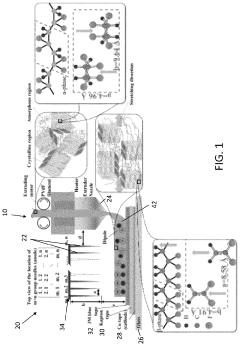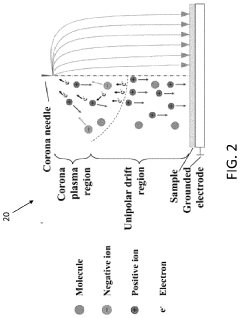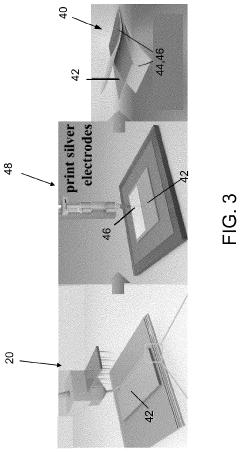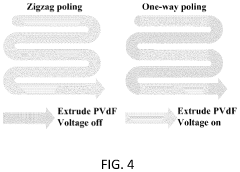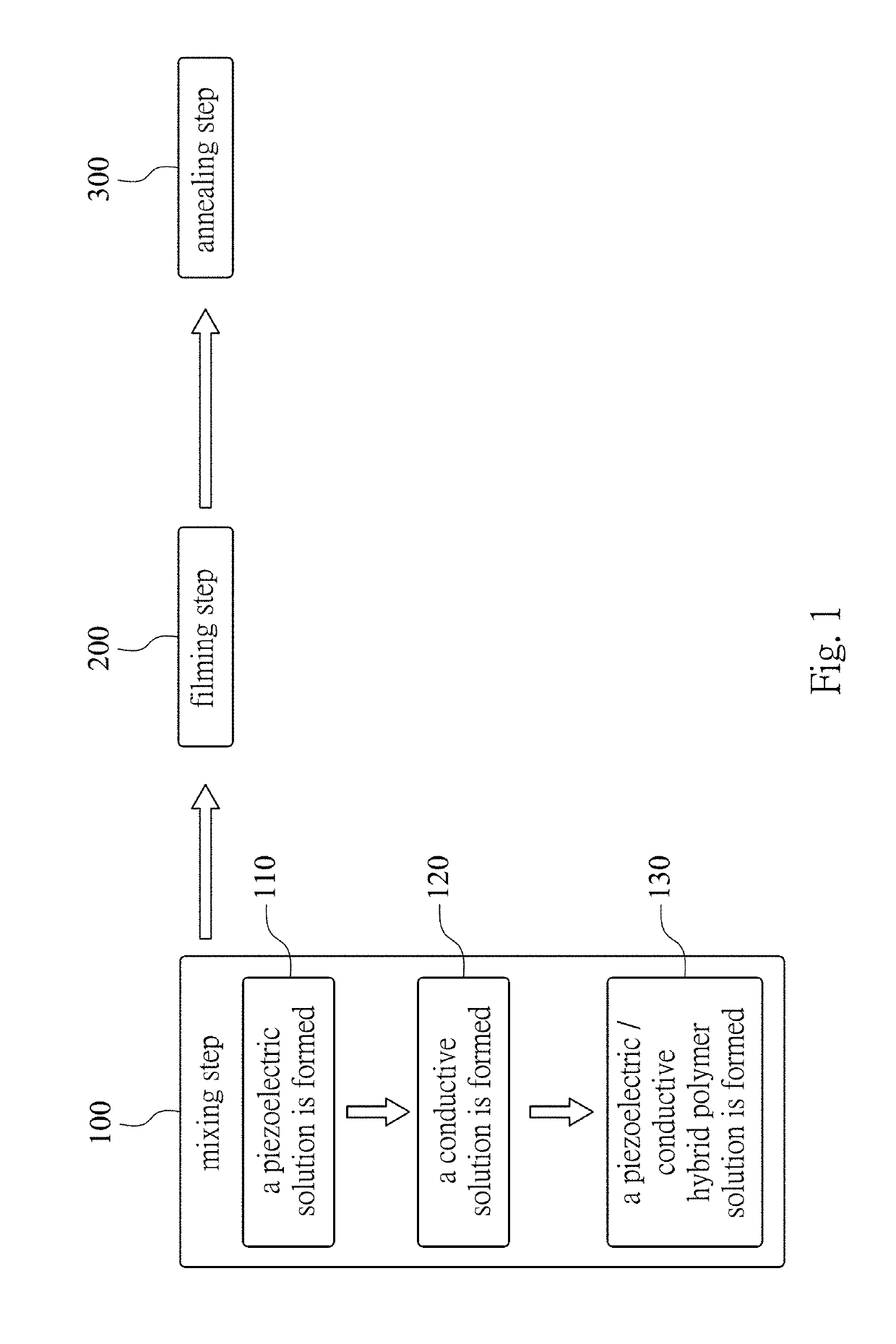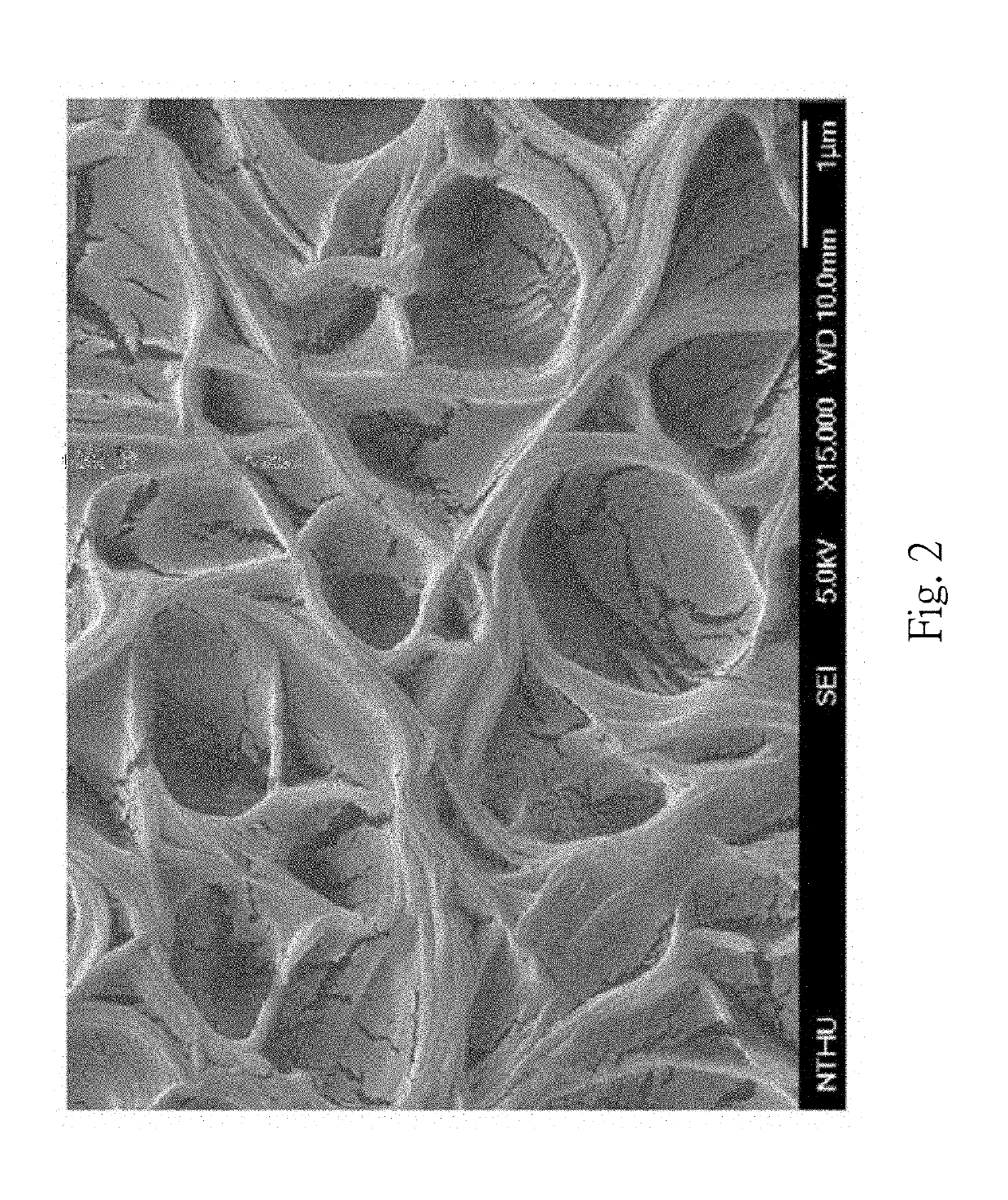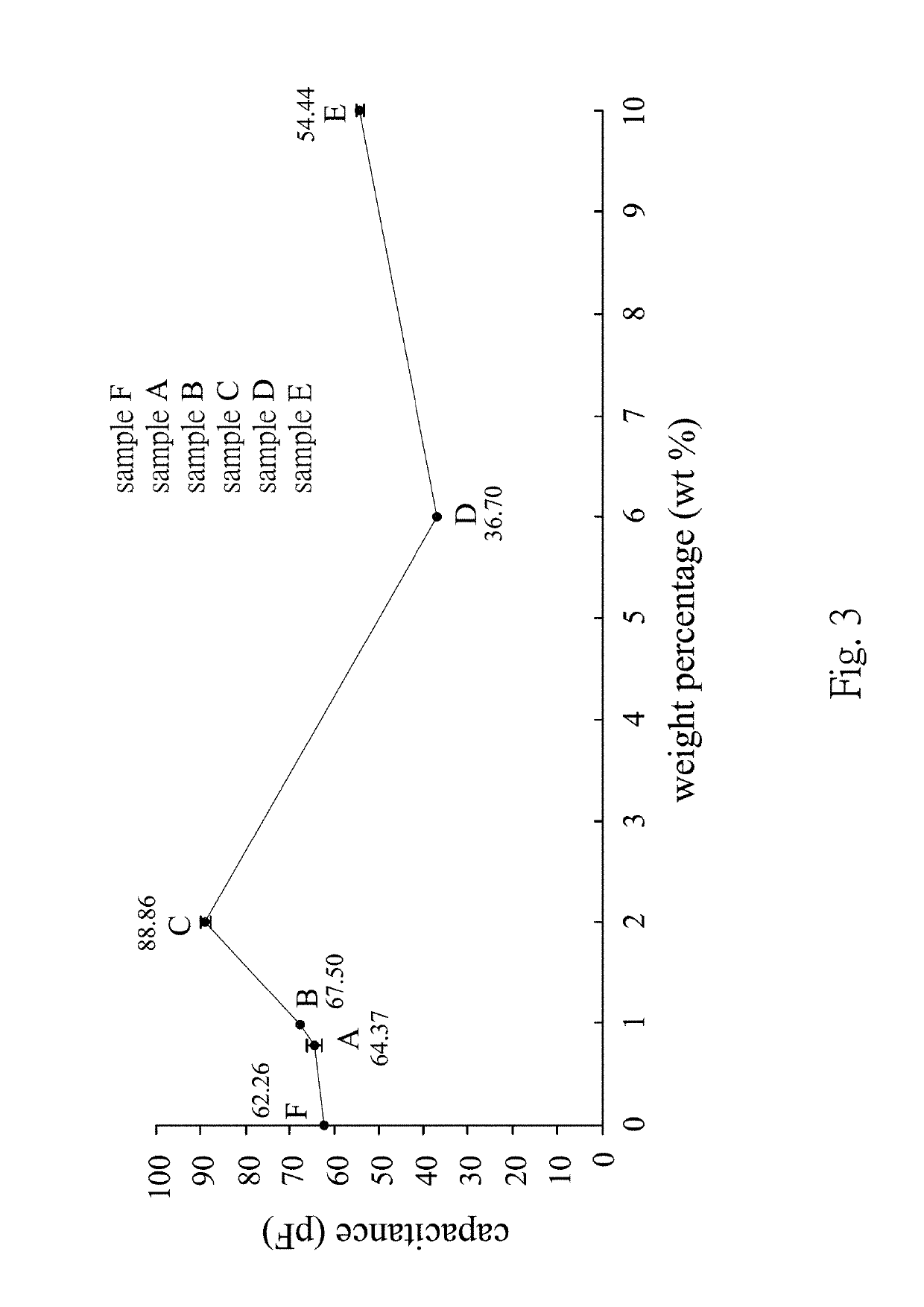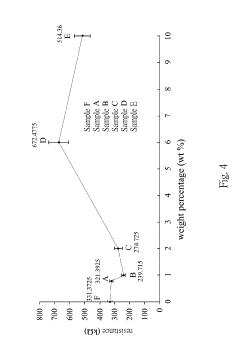How to Increase PVDF Efficiency in Piezoelectric Sensors?
PVDF Piezoelectric Background and Objectives
Polyvinylidene fluoride (PVDF) has emerged as a crucial material in the field of piezoelectric sensors, marking a significant milestone in the evolution of sensing technologies. The journey of PVDF in piezoelectric applications began in the late 1960s when its piezoelectric properties were first discovered. Since then, it has garnered substantial attention due to its unique combination of flexibility, durability, and sensitivity to mechanical stress.
The development of PVDF-based piezoelectric sensors has been driven by the growing demand for lightweight, flexible, and highly responsive sensing devices across various industries. These sensors have found applications in areas ranging from automotive and aerospace to healthcare and consumer electronics, showcasing the versatility and adaptability of PVDF technology.
As the field progresses, researchers and engineers are focusing on enhancing the efficiency of PVDF in piezoelectric sensors. This pursuit is motivated by the need for more sensitive, reliable, and energy-efficient sensing solutions. The primary objectives in this endeavor include improving the piezoelectric coefficient, enhancing the electromechanical coupling factor, and optimizing the overall sensor design to maximize energy conversion.
One of the key challenges in increasing PVDF efficiency lies in understanding and manipulating its molecular structure. The piezoelectric properties of PVDF are closely tied to its crystalline phases, particularly the β-phase, which exhibits the strongest piezoelectric response. Consequently, a significant portion of research is dedicated to developing methods to increase the β-phase content in PVDF films and fibers.
Another critical aspect of PVDF piezoelectric development is the exploration of composite materials. By incorporating nanoparticles or other piezoelectric materials into PVDF matrices, researchers aim to create hybrid structures with enhanced piezoelectric properties. This approach not only seeks to improve efficiency but also to tailor the material's characteristics for specific applications.
The ongoing technological evolution in PVDF piezoelectric sensors is closely aligned with broader trends in materials science and nanotechnology. Advancements in fabrication techniques, such as electrospinning and 3D printing, are opening new avenues for creating complex PVDF structures with optimized piezoelectric performance. These innovations are expected to play a crucial role in pushing the boundaries of sensor efficiency and functionality.
As we look towards the future, the objectives for PVDF piezoelectric research are multifaceted. They include not only enhancing the material's intrinsic properties but also improving manufacturing processes to ensure scalability and cost-effectiveness. Additionally, there is a growing emphasis on developing sustainable and environmentally friendly production methods, aligning with global trends towards green technology.
Market Analysis for High-Efficiency Piezoelectric Sensors
The market for high-efficiency piezoelectric sensors, particularly those utilizing PVDF (Polyvinylidene Fluoride), is experiencing significant growth driven by increasing demand across various industries. The global piezoelectric sensors market is projected to expand at a compound annual growth rate (CAGR) of over 5% from 2021 to 2026, with PVDF-based sensors playing a crucial role in this growth.
The automotive sector represents a major market for high-efficiency piezoelectric sensors. As vehicles become more advanced and electrified, the need for precise sensing technologies in areas such as engine management, tire pressure monitoring, and advanced driver assistance systems (ADAS) is growing rapidly. PVDF sensors, known for their flexibility and high sensitivity, are increasingly being adopted in these applications.
In the healthcare industry, the demand for high-efficiency piezoelectric sensors is driven by the growing emphasis on non-invasive diagnostic techniques and wearable medical devices. PVDF sensors are particularly valuable in applications such as ultrasound imaging, patient monitoring systems, and smart wearables due to their biocompatibility and ability to conform to complex shapes.
The industrial sector is another key market for high-efficiency piezoelectric sensors. In manufacturing and process industries, these sensors are essential for quality control, structural health monitoring, and predictive maintenance. The push towards Industry 4.0 and smart manufacturing is further accelerating the adoption of advanced sensing technologies, including PVDF-based sensors.
Consumer electronics represent a rapidly growing market segment for high-efficiency piezoelectric sensors. The increasing integration of touch-sensitive interfaces, haptic feedback systems, and motion sensing capabilities in smartphones, tablets, and wearable devices is driving demand for compact, energy-efficient sensors. PVDF sensors are well-suited for these applications due to their thin profile and flexibility.
Geographically, North America and Europe currently lead the market for high-efficiency piezoelectric sensors, owing to their advanced industrial and healthcare sectors. However, the Asia-Pacific region is expected to witness the highest growth rate in the coming years, driven by rapid industrialization, increasing automotive production, and growing investments in healthcare infrastructure.
The market is characterized by intense competition among key players, including TE Connectivity, Honeywell International, and Murata Manufacturing. These companies are focusing on research and development to enhance the efficiency and performance of PVDF-based sensors, aiming to capture a larger market share in this growing industry.
Current PVDF Efficiency Challenges
Despite the widespread use of PVDF in piezoelectric sensors, several challenges currently limit its efficiency. One of the primary issues is the relatively low piezoelectric coefficient of PVDF compared to ceramic materials. This inherent limitation restricts the sensor's sensitivity and overall performance, particularly in applications requiring high precision or low-level signal detection.
Another significant challenge is the temperature sensitivity of PVDF. The material's piezoelectric properties can be significantly affected by temperature fluctuations, leading to inconsistent sensor performance across different operating conditions. This temperature dependence can result in signal drift and reduced accuracy, especially in environments with variable temperatures.
The polarization stability of PVDF presents an additional hurdle. Over time, the polarization of PVDF can degrade, leading to a reduction in its piezoelectric response. This aging effect can compromise the long-term reliability and consistency of sensors, necessitating more frequent calibration or replacement.
Manufacturing consistency is also a critical challenge. Producing PVDF films with uniform thickness and consistent piezoelectric properties across large areas can be difficult. Variations in the manufacturing process can lead to inconsistencies in sensor performance, making it challenging to achieve reproducible results in large-scale production.
The mechanical properties of PVDF, while generally favorable for flexibility, can pose challenges in certain applications. The material's relatively low stiffness compared to ceramic piezoelectrics can limit its use in high-frequency applications or in scenarios requiring high mechanical strength.
Interfacing PVDF with electronic circuits presents another set of challenges. The high output impedance of PVDF sensors necessitates careful design of signal conditioning circuits to maintain signal integrity and minimize noise. This can add complexity to the overall sensor system design and potentially increase costs.
Environmental factors such as humidity and chemical exposure can also affect PVDF's performance. The material's susceptibility to these factors can lead to degradation of its piezoelectric properties over time, particularly in harsh or industrial environments.
Lastly, the efficiency of energy harvesting applications using PVDF is currently limited. While PVDF shows promise in energy harvesting due to its flexibility and ability to respond to low-frequency vibrations, the amount of energy that can be harvested is often insufficient for powering many practical devices without significant improvements in efficiency or energy storage solutions.
Existing PVDF Efficiency Enhancement Methods
01 PVDF membrane fabrication and modification
Various techniques are employed to fabricate and modify PVDF membranes to enhance their efficiency. These methods include blending with other polymers, surface modification, and incorporation of nanoparticles. Such modifications can improve the membrane's hydrophilicity, fouling resistance, and overall performance in applications like water treatment and separation processes.- PVDF membrane fabrication and modification: Various techniques are employed to fabricate and modify PVDF membranes to enhance their efficiency. These methods include blending with other polymers, surface modification, and incorporation of nanoparticles. Such modifications can improve the membrane's hydrophilicity, fouling resistance, and overall performance in applications like water treatment and separation processes.
- PVDF in energy storage applications: PVDF is utilized in energy storage devices, particularly in lithium-ion batteries and supercapacitors. Its high dielectric constant and excellent thermal stability make it an effective binder and separator material. Research focuses on optimizing PVDF formulations and structures to enhance energy density, cycle life, and overall efficiency of these energy storage systems.
- PVDF in piezoelectric and sensor applications: The piezoelectric properties of PVDF are exploited in various sensor and actuator applications. Researchers are developing novel PVDF-based materials and structures to improve sensitivity, responsiveness, and durability in devices such as pressure sensors, vibration detectors, and energy harvesters. These advancements contribute to increased efficiency in converting mechanical energy to electrical signals.
- PVDF in filtration and separation processes: PVDF membranes are widely used in filtration and separation processes due to their chemical resistance and mechanical strength. Ongoing research focuses on improving the efficiency of PVDF-based filtration systems through surface modifications, pore size control, and composite membrane development. These advancements aim to enhance flux, selectivity, and fouling resistance in applications such as water treatment and gas separation.
- PVDF in coating and protective applications: PVDF's excellent weatherability and chemical resistance make it suitable for protective coatings and films. Research in this area focuses on improving the efficiency of PVDF-based coatings by enhancing their adhesion, durability, and functional properties. These developments aim to extend the lifespan and performance of coated surfaces in various industrial and architectural applications.
02 PVDF in energy storage applications
PVDF is utilized in energy storage devices, particularly in lithium-ion batteries and supercapacitors. Its high dielectric constant and excellent thermal stability make it an effective binder and separator material. Research focuses on optimizing PVDF formulations and structures to enhance energy density, cycle life, and overall efficiency of these energy storage systems.Expand Specific Solutions03 PVDF in piezoelectric and sensor applications
The piezoelectric properties of PVDF are exploited in various sensor and actuator applications. Researchers are developing novel PVDF-based materials and structures to improve sensitivity, response time, and durability of piezoelectric devices. These advancements contribute to more efficient energy harvesting systems and high-performance sensors for diverse industrial and medical applications.Expand Specific Solutions04 PVDF in filtration and separation processes
PVDF membranes are widely used in filtration and separation processes due to their chemical resistance and mechanical strength. Ongoing research focuses on enhancing the efficiency of PVDF-based filtration systems through surface modifications, pore size control, and composite membrane development. These improvements aim to increase flux, selectivity, and fouling resistance in applications such as water treatment and gas separation.Expand Specific Solutions05 PVDF in coating and protective applications
PVDF's excellent weatherability and chemical resistance make it suitable for protective coatings and films. Research in this area focuses on improving the durability, adhesion, and performance of PVDF-based coatings. Advancements include the development of nanocomposite coatings, self-cleaning surfaces, and environmentally friendly formulations for applications in construction, automotive, and electronics industries.Expand Specific Solutions
Key Players in PVDF Sensor Industry
The market for PVDF-based piezoelectric sensors is in a growth phase, driven by increasing demand in various industries. The global piezoelectric devices market, including PVDF sensors, is projected to reach significant market size in the coming years. Technologically, PVDF efficiency in piezoelectric sensors is advancing, with key players like Kureha Corp., Mitsui Chemicals, and SABIC Global Technologies BV leading research and development efforts. Academic institutions such as Central South University and Zhejiang University are contributing to technological advancements. The technology's maturity is moderate, with ongoing research focusing on improving PVDF's piezoelectric properties, sensor design, and manufacturing processes to enhance efficiency and performance in various applications.
Kureha Corp.
Naval Research Laboratory
Core Innovations in PVDF Piezoelectric Materials
- The integration of corona poling-assisted additive manufacturing (EPAM) using a modified FDM 3D printer with a corona poling apparatus, where the PVdF film is simultaneously printed and poled, allowing for the alignment of dipoles and formation of β-phase regions during the printing process, enabling the production of complex geometries without the need for post-processing electric poling.
- A method involving the mixing of PVDF-TrFE with PEDOT:PSS and subsequent nano-imprint processing to form a piezoelectric/conductive hybrid polymer, enhancing output current, voltage, and power by altering the surface structure and crystallinity.
Environmental Impact of PVDF Production
The production of Polyvinylidene Fluoride (PVDF) for piezoelectric sensors has significant environmental implications that warrant careful consideration. The manufacturing process of PVDF involves the use of various chemicals and energy-intensive procedures, which can contribute to environmental pollution and resource depletion if not managed properly.
One of the primary environmental concerns associated with PVDF production is the emission of greenhouse gases. The polymerization process requires high temperatures and pressures, leading to substantial energy consumption and consequent carbon dioxide emissions. Additionally, the production of the monomer vinylidene fluoride often involves the use of chlorofluorocarbons (CFCs) or hydrochlorofluorocarbons (HCFCs), which are known to deplete the ozone layer and contribute to global warming.
Water pollution is another critical issue in PVDF manufacturing. The process generates wastewater containing various chemical compounds, including unreacted monomers, solvents, and other potentially harmful substances. If not treated adequately, these effluents can contaminate water bodies and pose risks to aquatic ecosystems and human health.
The use of fluorine-containing compounds in PVDF production raises concerns about the potential release of fluorinated gases, which are potent greenhouse gases with long atmospheric lifetimes. Proper handling and containment of these substances are essential to minimize their environmental impact.
Furthermore, the production of PVDF relies on non-renewable petroleum-based resources, contributing to the depletion of fossil fuels. This dependency on finite resources raises questions about the long-term sustainability of PVDF production, especially as demand for piezoelectric sensors continues to grow.
Solid waste generation is another environmental aspect to consider. The manufacturing process may produce by-products and waste materials that require proper disposal or recycling. Improper management of these wastes can lead to soil contamination and other environmental hazards.
To mitigate these environmental impacts, the PVDF industry is exploring various strategies. These include improving energy efficiency in production processes, developing cleaner synthesis routes, implementing closed-loop systems to minimize waste and emissions, and investigating bio-based alternatives to reduce reliance on petroleum feedstocks.
Additionally, efforts are being made to enhance the recyclability and end-of-life management of PVDF products. This includes developing more efficient recycling technologies and designing products with easier disassembly and material recovery in mind.
As environmental regulations become more stringent globally, PVDF manufacturers are increasingly focusing on adopting greener production methods and technologies. This shift not only helps in reducing the environmental footprint but also aligns with the growing market demand for more sustainable materials in various applications, including piezoelectric sensors.
Standardization of PVDF Efficiency Metrics
The standardization of PVDF efficiency metrics is crucial for advancing the development and application of piezoelectric sensors. Currently, there is a lack of universally accepted standards for measuring and reporting the efficiency of PVDF in these devices, which hinders meaningful comparisons and slows progress in the field.
To address this issue, a comprehensive framework for standardizing PVDF efficiency metrics should be established. This framework should encompass key performance indicators such as piezoelectric coefficient (d33), electromechanical coupling factor (k), and voltage sensitivity. These metrics provide essential information about the material's ability to convert mechanical energy into electrical energy and vice versa.
One proposed approach is to develop a standardized testing protocol that specifies sample preparation methods, measurement conditions, and data analysis techniques. This protocol should include guidelines for sample size, thickness, and electrode configuration to ensure consistency across different research groups and manufacturers. Additionally, it should define standard environmental conditions, such as temperature and humidity, under which measurements should be conducted.
The testing protocol should also address the frequency dependence of PVDF efficiency, as piezoelectric properties can vary significantly with the frequency of applied stress or electric field. Establishing standard frequency ranges for different applications (e.g., low-frequency vibration sensing, high-frequency ultrasound) would facilitate more accurate comparisons between different PVDF formulations and sensor designs.
Another critical aspect of standardization is the development of reference materials with well-characterized properties. These reference materials would serve as benchmarks for calibrating measurement equipment and validating experimental results. This approach would help reduce inter-laboratory variations and improve the reliability of reported efficiency metrics.
To ensure widespread adoption, the standardization effort should involve collaboration between academic institutions, industry partners, and regulatory bodies. International organizations such as IEEE or ISO could play a crucial role in formalizing and disseminating these standards. Regular review and updates to the standards would be necessary to keep pace with technological advancements and emerging applications of PVDF in piezoelectric sensors.
Implementing standardized efficiency metrics would not only facilitate more accurate comparisons between different PVDF formulations and sensor designs but also accelerate innovation in the field. Researchers and manufacturers would have a clear benchmark against which to measure improvements, leading to more rapid development of high-efficiency PVDF-based piezoelectric sensors for various applications.
